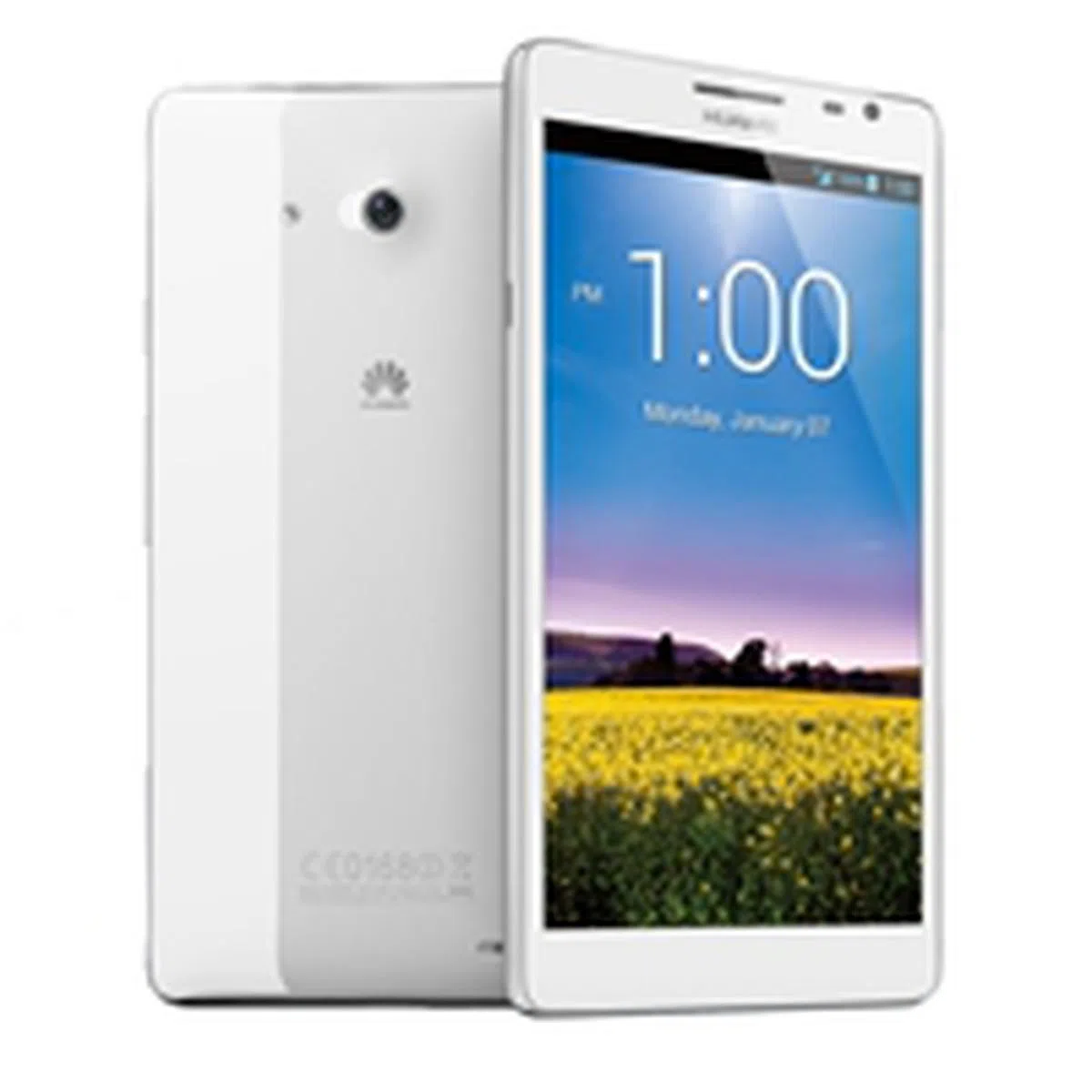Huawei Ascend Mate - Is Bigger Always Better?
Huawei blurs the line further between smartphones and tablets with the 6.1-inch Ascend Mate. While smartphones with big displays are getting more popular among consumers today, is the Huawei Ascend Mate a little too big for its own good? Let's find out in this review.
By HardwareZone Team -
Overview
We first saw the Huawei Ascend Mate at CES 2013 five months ago. Back then, Huawei took the crown away from Samsung for having the biggest display ever on a smartphone. Seeing how things are always changing in this highly competitive industry, it was not long before Samsung struck back with its Galaxy Mega 6.3 in April.
Nonetheless, it cannot be denied that phone makers these days are pushing the boundaries of what define, or should we say, differentiate, a smartphone and a tablet. A crucial issue that we will attempt to address in this review is whether devices such as the Huawei Ascend Mate can effectively replace the need for having a separate phone and tablet. More importantly, is the smartphone with a screen size above 6 inches a practical device? Before that, here's a quick look at the specs of the Huawei Ascend Mate:
 | Key highlights of theHuawei Ascend Mate
|
Design
The Ascend Mate is without a doubt a massive phone. The sheer size means that it is only suitable for consumers who either have very big hands or do not mind carrying it in their pockets or bags. Here's a quick comparison with the Samsung Galaxy Note II, Galaxy Mega 5.8, Galaxy Mega 6.3 and the LG Optimus G Pro to put things into perspective:
Device | Huawei Ascend Mate | Samsung Galaxy Mega 6.3 | Samsung Galaxy Mega 5.8 | ||
Display | 6.1-inch | 6.3-inch | 5.8-inch | 5.5-inch | 5.5-inch |
Size | 163.5 x 85.74 x 9.9mm | 167.6 x 88 x 8.0mm | 162.6 x 82.4 x 9.0mm | 151 x 81 x 9.4mm | 150.2 x 76.1 x 9.4mm |
Weight | 198g | 199g | 182g | 180g | 160g |

From left to right: Samsung Galaxy Mega 5.8, Huawei Ascend Mate, Samsung Galaxy Mega 6.3.

The Huawei Ascend Mate is approaching the 7-inch tablet territory. <br>From left to right: ASUS Nexus 7, Huawei Ascend Mate, Sony Xperia Z and Apple iPhone 5.
As seen in the table above, the Ascend Mate is longer, wider and heavier than most of its counterparts. This is mainly attributed to the 6.1-inch display and massive 4,050mAh non-removable battery. Having said that, it is no longer viable to operate the phone in one hand as it is near impossible to reach the other side of the screen with our thumb. Huawei has included an option to enable one-handed operations on the Ascend Mate, which we will discuss in detail in our next section.

You need two hands to use the Huawei Ascend Mate properly.
With that dimensions and weighing at 198g, we do not consider the Ascend Mate to be pocketable. While it can fit in our pair of slim fit jeans, there is a conspicuous bulge. For consumers who keep their phones in the pockets when sitting down, we highly advise against that in the case of the Ascend Mate as you will feel uncomfortable.
The Ascend Mate is quite decent in terms of build quality. For a device of its size, the choice of using plastics to keep the weight to a minimum is acceptable. It is also fortunate that Huawei used matte plastic for the back and sides of the Ascend Mate, making it easier to grip.

The matte back helps to have a better grip of the massive Huawei Ascend Mate.
The standard suite of connectivity ports and buttons are scattered on all four sides of the Ascend Mate. Starting from the top, you can find the micro-SIM card slot and 3.5mm audio output jack. On the right side of the device are the power button and volume controls, both of which are sufficiently raised for easy access. At the bottom is the microUSB port which is used for charging and file transfer. Last, but not least is the microSD memory card slot on the left side of the device.
Features
The Ascend Mate runs on Android 4.1.2 Jelly Bean with Huawei's own Emotion user interface (UI), which we had a preview on the Ascend P2 at MWC 2013. The level of customization is similar to HTC and LG, but not as drastic as Samsung. Well, let's take a look at this Emotion UI:
Lock Screen

You can customize three out of four shortcuts on the lock screen.
Placing shortcuts on the lock screen is nothing new these days, but there is one slight annoyance in Huawei's implementation. If you notice, the unlock icon is at the bottom. This means that you have to swipe down to unlock the phone. While you can customize the other three shortcuts (left, top and right) to other apps, the unlock icon remains fixed.
The conventional method of unlocking the screen is swiping from left to right, although Samsung Galaxy S III / 4 users can swipe in almost any direction and HTC One users slide up. By adding another combination to the mix, users switching from other Android users may get confused. We often find ourselves swiping left to right to only access Messages.
No App Drawer

You still can group apps into folders. To uninstall an app, simply hold and drag it to the top.
The first thing any Android user will notice is the absence of an app drawer where all the apps in the device are listed. This concept is similar to Apple's iOS, and may be a bugbear for seasoned Android users. Apps that are downloaded will appear on the third home screen. This differs from stock Android or the UIs of other Android devices where downloaded apps will always appear on the main home screen (if there's space, of course).
Hide Navigation Bar

The option to hide the navigation bar comes in handy especially if you want to fully maximize the 6.1-inch screen.
If you haven't noticed, the Ascend Mate does not have any physical navigation buttons. It follows the standards set by Google to use on-screen navigation buttons. The drawback of on-screen controls is that it occupies a portion of the screen.
To address this issue, Huawei includes an option to hide the navigation bar. To enable this option, go to Settings > All > Navigation bar. Once enabled, a down arrow will appear on the extreme left of the navigation bar. To hide the bar, simply touch the down arrow.

Depending on what you are doing, the option to hide the navigation bar can reveal more things on the display.
One-handed Operations

The one-handed operations option helps to a certain extent in the usability aspect of the Huawei Ascend Mate.
As mentioned earlier in the article, Huawei knows that a 6.1-inch display isn't exactly easy for consumers to navigate using their fingers. Therefore, the company added the option for one-handed operations. This is also nothing new as we've seen a similar implementation on the Samsung Galaxy Note II.
The 'One-hand operations' option basically optimizes the unlock screen, dialer, in-call keypad and keyboard for one-hand usage. You can move the keyboard or dial keypad to the left or right depending on your preference. We find this feature to aid in our usage of the Ascend Mate to a certain extent, but the massive form factor is still too overwhelming.
Suspended Button

Known as the suspended button, it is a button that you can place anywhere along the sides of the display. Huawei's implementation of the suspended button seems like a cross between Sony's Small Apps and Samsung's Multi-Screen. It contains four shortcuts (Notes, Messages, TPlayer and Calculator).
The functionality is limited to these four apps, of which only the Calculator and Notes app will appear as small windows on the same screen. Tapping on Messages and TPlayer will launch straight into the apps.
Performance
The Ascend Mate is powered by the company's own chipset, the Huawei Hi-Silicon K3V2 quad-core processor which debuted last year at MWC 2012. Similar to why Apple and Samsung design their own chipsets, Huawei believes that the development of in-house processors allows better optimization of both the hardware and software aspects, and this in turn will lead to an overall better performance and longer battery mileage.
To assess how the Huawei Ascend Mate fares against the competition, we ran the Quadrant benchmark. The test evaluates CPU, memory, I/O and 3D graphics of Android devices. In this comparison, we pit the Ascend Mate against the Samsung Galaxy Note II, Samsung Galaxy S4, ASUS PadFone Infinity and Sony Xperia Z.
Device | Huawei Ascend Mate | ||||
CPU | Huawei Hi-SiliconK3V2 quad-core 1.5GHz | Exynos 4412 Quad
quad-core 1.6GHz | Qualcomm Snapdragon 600 quad-core 1.9GHz | Qualcomm Snapdragon 600 quad-core 1.7GHz | Qualcomm Snapdragon S4
quad-core 1.5GHz |
GPU | Vivante GC4000 | Mali-400MP | Adreno 320 | Adreno 320 | Adreno 320 |
RAM | 1GB | 2GB | 2GB | 2GB | 2GB |
OS | Android 4.1 | Android 4.1 | Android 4.2.2 | Android 4.1 | Android 4.1 |

Despite its claims of having better overall performance due to the in-house processor, the Ascend Mate trailed behind the competition in the Quadrant benchmark. To put things into a clearer perspective, the Ascend Mate is on-par with the likes of the 4G-enabled Samsung Galaxy S III (5,260) and ahead of the HTC One X (4,025).
Synthetic benchmarks aside, we found the user experience on the Ascend Mate to be slightly sluggish. This is surprising since Android 4.1 Jelly Bean should theoretically address the lagging issue prevalent in previous Android versions. There were noticeable instances of apps taking slightly longer to open or close, and the overall user experience wasn't as smooth as we've thought it would be on Jelly Bean devices.
Multimedia Performance
The main highlight of the Ascend Mate is its massive 6.1-inch HD IPS+ display. With LG being the only phone vendor so far to introduce a full HD 5.5-inch display, we are willing to forgive the fact that the Ascend Mate comes with a HD resolution of just 1,280 x 720 pixels.
As it is an IPS+ display, you can expect very good viewing angles and balanced color reproduction. For screen purists, there is an option under the Display setting where you can adjust the color temperature to your liking. It is also noteworthy to mention that the Ascend Mate is one of the few phones (Nokia Lumia 920/925 and Samsung Galaxy S4 being the others) in the market that can be used with gloves on. This feature can be enabled or disabled in the settings.

You can tweak the display to look warmer or cooler.
Due to its screen size, the Ascend Mate is very well suited as a multimedia device to browse the Internet, play games or watch movies. The only concerns of using a device with such screen sizes are the loss of personal privacy and inviting weird stares from people around you.

The 6.1-inch screen size enables you to view content more comfortably. <br> From left to right: Apple iPhone 5 (4-inch), LG Nexus 4 (4.7-inch), Sony Xperia Z (5-inch) and Huawei Ascend Mate (6.1-inch).
It is strange that for a device of its size, Huawei only included 8GB internal storage space. Out of the box, you only have 4.18GB available storage space. Fortunately, the Ascend Mate comes with a microSD card slot that supports cards up to 32GB.
Imaging Performance
The Ascend Mate comes with an 8-megapixel rear autofocus camera with high dynamic range (HDR) support and a 1-megapixel HD front-facing camera. We put its rear camera through our standard imaging test and found that image quality is only about average for an 8MP camera.

The image quality is average for an 8-megapixel camera. We've seen better from other smartphones. Check out the close-up shots below for further scrutiny.
Battery Mileage
Our standard battery test for mobile phones includes the following parameters:
- Looping a 800 x 480-pixel video with screen brightness and volume at 100%
- Wi-Fi and Bluetooth connectivity turned on
- Constant data streaming through email and Twitter
Specs/Device | Huawei Ascend Mate | Samsung Galaxy Note II | Samsung Galaxy S4 | ASUS PadFone Infinity | Sony Xperia Z |
Processor |
|
|
|
|
|
Display Size |
|
|
|
|
|
Display Type |
|
|
|
|
|
Display Resolution |
|
|
|
|
|
Dimensions |
|
|
|
|
|
Weight |
|
|
|
|
|
Battery |
|
|
|
|
|



With a 6.1-inch display and a quad-core processor, it is actually quite impressive that the Ascend Mate managed to last 8 hours and 31 minutes in our standard battery test. Its better-than-expected battery life is attributed to its equally massive battery which is rated at 4,050mAh.
Aside from the Sony Xperia Z, the Ascend Mate registered one of the highest power consumption at 2W. The 5.5-inch Samsung Galaxy Note II managed to maintain a low 0.89W. It is however, too early to conclude if such numbers are typical of 6-inch and above devices and we have to see how the Samsung Galaxy Mega 6.3 fares.
Not surprisingly, its massive dimensions and weight caused the Ascend Mate to rank last in our Portability Index where each device is assessed on its ability to balance battery mileage with its size and portability.
While our battery test is quite strenuous and is used to help us establish a base line for comparing between various smartphone offerings, in an actual usage scenario, we were able to get close to a day and a half of battery life. This included our regular weekday schedule of calls, email, web-surfing and social media usage.
If you are looking to maximize the battery mileage on the Ascend Mate, there is a power management feature on the device. Known as the Power Manager, you can choose between three modes: Intelligent, Normal and Optimum performance.

Three power saving modes are available on the Huawei Ascend Mate.
Conclusion
At the start of the review, we posted two questions on the Huawei Ascend Mate. First, does the Ascend Mate replace the need to have a separate phone and tablet device? Second, is a 6.1-inch smartphone practical in our daily life?
Our answer to the first question is a resounding yes. It's more pocketable compared to 7-inch tablets; at the same time delivering comparable features and functions such as long battery life and large screen estate. We don't foresee its portability to be an issue for ladies since they are usually carrying their handbags around. For the gentlemen, the Ascend Mate will feel like a brick in slim fit or skinny jeans, and is better held in the hands, with maybe a folio case.
As for the second question, the Ascend Mate will not be practical for the average consumer. It appeals to a niche market segment, in particular those who are using the Samsung Galaxy Note II and those who do not mind such mega-sized devices. Why would we advise the average consumer against getting the Ascend Mate? Well, for one, we feel it is too massive for one-handed operation, and the 6.1-inch display is an overkill for basic to moderate multimedia consumption purposes. Then again, many of us were wrong about the 'phablet' that is the Galaxy Note when it first launched.
Priced at S$638, the Huawei Ascend Mate basically undercuts the competition. Samsung recently announced two Galaxy Mega devices, the Mega 5.8 (S$598) and Mega 6.3 (S$798). On paper, the Ascend Mate trumps both devices in the processor department (dual-core vs. quad-core), screen size (compared to the Galaxy Mega 5.8) and battery capacity. On the other hand, Huawei is not particularly known to deliver software updates swiftly for its mobile devices; so Samsung takes the cake in this area. Both Galaxy Mega devices also run on a newer version of Android (4.2.2) and the Galaxy Mega 6.3 is LTE-enabled. The Ascend Mate has neither NFC or 4G support.
All in all, if large screen size is your top priority and you can overlook the flaws we've detailed above, the Ascend Mate can be considered value for money. At the moment, the laggy interface prevents us from recommending it wholeheartedly. Hopefully, this can be resolved via software updates in the near future.

The Huawei Ascend Mate excels at performing the functions of a tablet, but sacrifices the portability, mobility and usability that a conventional smartphone is known for.
Our articles may contain affiliate links. If you buy through these links, we may earn a small commission.

